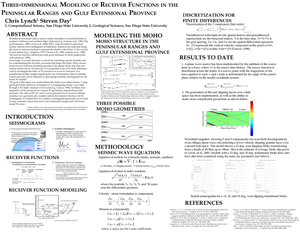 |
||||||||
 |
 |
 |
 |
 |
| Three-Dimensional Modeling of Receiver Functions in the Peninsular Ranges and Gulf Extensional Province | ||
|
Broadband teleseismic data is used to obtain estimates of crustal
thickness in southern California and northern Baja California
[e.g. Ichinose et al., 1996; Zhu and Kanamori, 1999; Lewis et
al., 2000, 2001]. Data recorded at individual seismic stations
from earthquakes at teleseismic distances are analyzed using the
receiver function method to estimate the depth to the Moho in
the vicinity of each station [e.g., Langston, 1979; Owens et al.,
1984; Ammon et al., 1990]. The receiver function method provides
point estimates of Moho depth [Zhu and Kanamori, 1999].
Knowledge of crustal structure is critical for estimating seismic hazards, and for understanding the dynamic processes that shape the Earth. Most conventional receiver function modeling assumes a flat planar Moho and does not include effects due to 3D structure. A 3D, finite difference, staggered-grid, | ||
|
elastodynamic seismic wave propagation code
[e.g. Graves, 1996] is being used to investigate the effect of 3D
structure on receiver functions. This code has been modified to
produce a plane wave that is obliquely incident on various material
interfaces and the free surface.
Further insight regarding the use of teleseismic data to estimate crustal structure can be obtained by data to estimate crustal structure can be obtained by generating synthetic seismograms for different 3D models. Synthetic seismograms have been produced for various 3D geometries representing the Moho structure underlying northern Baja California, (Baja California Norte, Mexico). The ratio of SH, SV and P waves generated by P waves at oblique incidence on a geometrically complex solid-solid material interface will also be investigated. The synthetic seismograms generated are being used to generate receiver functions which can then be used to help constrain crustal structure in the Peninsular Ranges and Gulf Extensional Province. |
||
| • Other Abstracts • | ||
